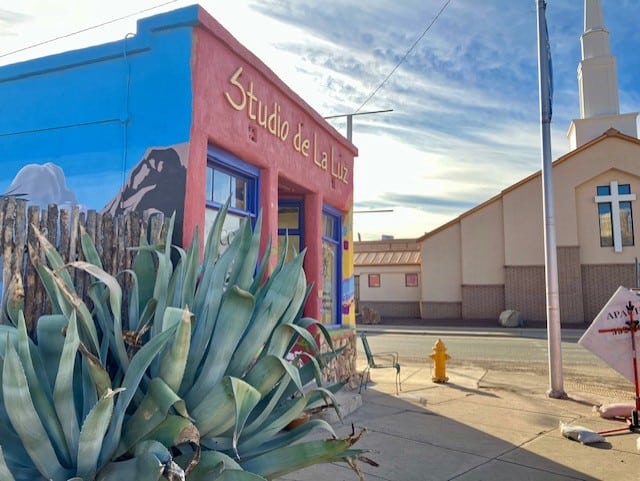Photography by Tom Sharpe
Blame it on the Internet, Amazon and changing reading habits. Bookstores, especially independent ones, are rare in most small towns. But Truth or Consequences, population 6,000, now has three.
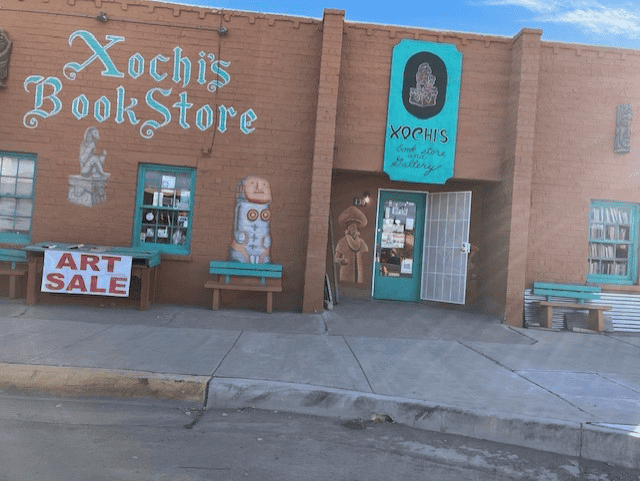
Xochi’s is the town’s veteran bookstore, specializing in rare books about the Southwest and Latin America, plus artifacts and art. Stan Sokopow opened it in 1993 at 430 N. Broadway. For the last three years, it has been the town’s only bookstore, other than the extensive book rack at Geronimo Springs Museum.
In December, two new bookstores opened along Broadway:
— Black Cat Books and Coffee, 128 N. Broadway, which closed during the pandemic, reopened Dec. 1 under new management by Rebecca Pomeroy who hopes bring the place back to the cultural nexus it once was.
— DCG Enterprises or The Serial Murder Communication Emporium, opened Dec. 2 by Dirk C. Gibson in Studio de la Luz, a former yoga and massage studio, at 308 S. Pershing, at the northeast corner of Pershing and Broadway.
Retired UNM prof’s bookshop focuses on serial murder, UFOs
Gibson, 70, recently moved to Truth or Consequences from Albuquerque after retiring from 25 years as a popular professor of communications at the University of New Mexico. His new bookstore may be one of the most unusual anywhere. It features his own work from years of
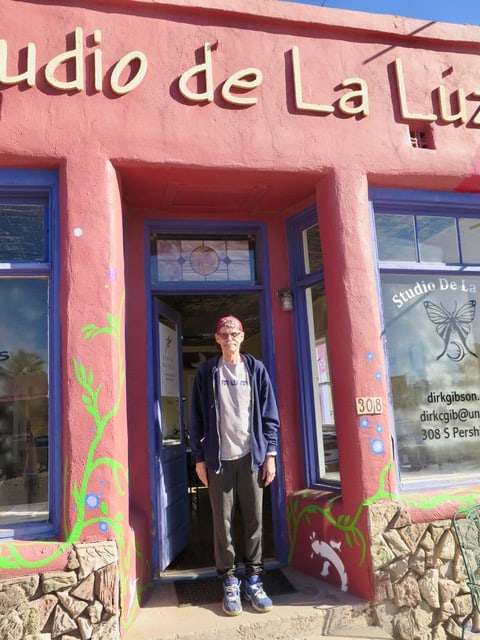
research into serial murders, space travel, UFOs, product recalls and famous FBI cases — about a dozen complete books plus packets of copies of FBI files and other documents, with prices ranging from $9 to $100. There is also a collection of books he used in his research, priced at $30 to $50.
If you have an interest in one of his topics, you should stop in and browse. You may find valuable nuggets of information not available elsewhere — great grazing grounds if you’re looking for a subject for a thesis or even your own book. He has tables and chairs set up, with one table devoted to teaching you how to understand five types of documents. Gibson is glad to talk to you. He says meeting new people is one of his main objectives. Even if he has nothing pertinent to your particular interest, chances are he can tell you something about it and recommend how to find more.
If the secondary title of Gibson’s shop, The Serial Murder Communication Emporium, gives you pause, fear not. Gibson’s aim is not to promote serial murder, but to analyze it — especially how its practitioners communicate with their victims, the media and the police. He points out that serial murder is not mass murder — like the frequent school shootings. Serial murder involves one or more persons’ killing one or more other persons at a time over an extended period.
Arguably the first and most famous serial murderer was “Jack the Ripper,” the moniker of whomever killed at least five poor women in London between 1888 and 1891, but escaped capture. Gibson’s theory is that it was a conspiracy to draw attention to urban poverty and crime. The shop has a blowup of a note, signed Jack the Ripper, that taunts the police that he is already eying his next victims. It is decorated with bloodstains (probably animal blood) and macabre drawings of a knife and sword, a skull and crossbones, a coffin and a skeleton. “My bloody whim must have its play,” says the note. “I will kill myself to escape the scaffold. I know you cannot catch me. Be ever present in your dreams.” “Killers like publicity,” Gibson said. “Serial murder is a game. Serial murderers use the media to punish the cops. If we could just give public safety information and not sensationalize it, we could cut it in half.”
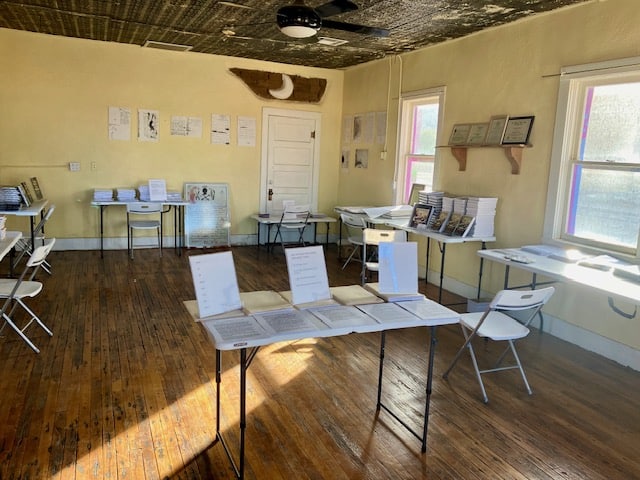
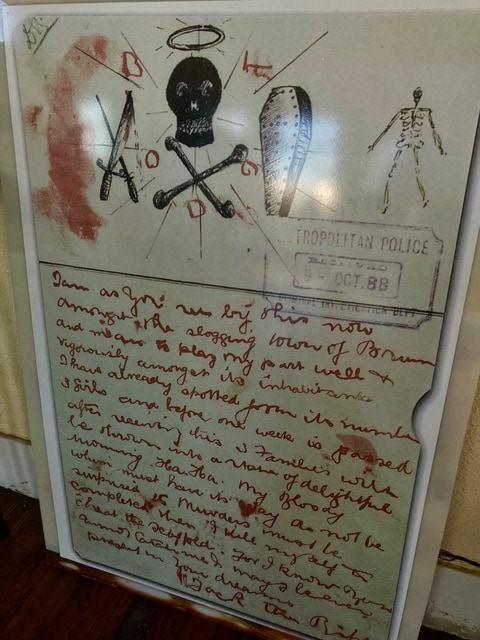
Dirk Gibson’s new store is set up with tables and chairs so you can sit down and study his books and documents. The props include a blowup of a note to the London Police from “Jack the Ripper.”
The shop carries several of Gibson’s books about serial murder. None of them mention David Parker Ray, an Elephant Butte man suspected in the disappearances of several women. But Gibson said Ray exhibited an unusual sort of communication by playing his victims recordings of himself describing what he was about to do to them in his torture-chamber trailer called the “Toy Box.” Ray died in prison in 2002 after being convicted the previous year of kidnapping and torturing a woman who escaped the trailer. Elephant Butte Reservoir was searched, but no bodies were found, so Ray cannot accurately be called a murderer.
Gibson has a book about what was arguably the mass murder of 33 inmates in the 1980 riot at the Penitentiary of New Mexico, south of Santa Fe. He says its causes included overcrowding, bare-bones budgeting, nepotism, corruption, bad food, security lapses, wrongly branding some inmates as “snitches” so the others would retaliate against them and unresponsiveness to repeated warnings that “things were about to blow.”
Some of the threads for Gibson’s research began when he was graduate student at Indiana University in the late 1970s (he got his doctorate there in 1983), and was one of the first people allowed to read through old FBI reports in bureau’s headquarters in Washington, D.C., courtesy of the Freedom of Information Act. One of the main things he learned, he said, was how one-sided the investigation was into the fatal shootings of four student protestors at Kent State University in Ohio by the National Guard on May 4, 1970. “It was very close to that era, so that affected me,” he said. ”There were behind-the-scenes conversations about how to punish the rioters. … They didn’t want any repercussions to be put on any political actors or National Guard actors.“
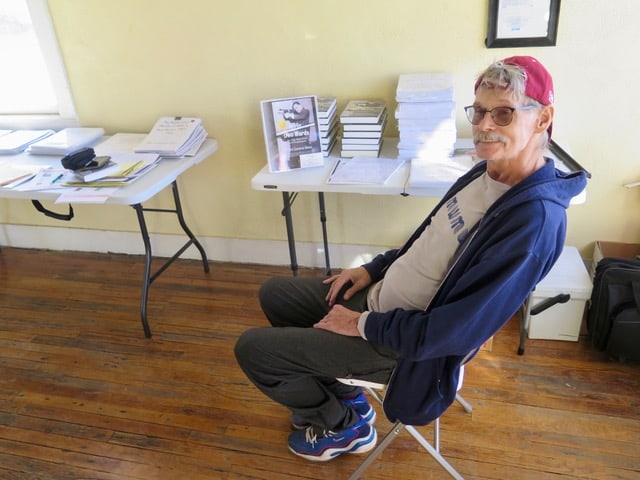
The first thing that caught my eye in his bookstore was his most recent book, “In His Own Words: How J. Edgar Hoover Directed the FBI through Marginalia,” published last year and marked $40. I bought it, but had I expected doodles of the director in drag, I would have been disappointed. Hoover’s marginalia reveals nothing about homosexuality and/or crossdressing, nor would one expect it to on an official record when either would be a criminal offense. “There is no proof, but plenty of rumor,” Gibson writes. The book has plenty of references to Clyde Tolson, Hoover’s second-in-command at the FBI and his lifelong companion. But when I suggested Hoover and Tolson’s relationship was more than casual, he got angry. “I’m a scholar, not a yellow journalist,” he said.
To Gibson’s credit, the marginalia reproduced proves Hoover was obsessed with his public image and curious about flying “discs” found in the Southwest. When an agent recommended caution in joining the Army investigation because similar cases turned out to be hoaxes, Hoover responded, “[B]efore agreeing to it we must insist upon full access to discs involved.” Hoover “did things by the book,” Gibson said. “I don’t think he ran amok as much as civil libertarians at the time thought that he did.”
There are also several books about space travel. One mentions Sierra County’s Spaceport America and similar private space projects around the world. But the book was published in 2012, one year after the Spaceport America opened and there were expectations of an era of recreational trips into space. One wonders what the forecast is now that Virgin Galactica is cutting back.
Gibson’s just beginning to learn about the retail book business. He may be overestimating the market value for books in general, especially second-hand ones and textbooks. But I wish him luck. He is a sincere, serious scholar and he deserves our support. His hours remain uncertain, but you can usually find him there most afternoons later in the week. He also is looking at starting a series of Chautauqua lectures and holding slideshows of his hundreds of photos of UFOs — now called UAPs for unidentified anomalous phenomenon.
“The neat thing is, I can meet people here,” he said. “I’m going to spend a lot of time sitting out front. ,,, I want to make this place the main entertainment center this side of Main Street.”
Black Cat reincarnated as a vortex for creativity, at the far east end of downtown
For nearly two decades, Black Cat Books and Coffee, 128 N. Broadway, was a cultural center for Truth or Consequences — offering a wide selection of books and subjects, with frequent poetry readings and book signings, and the first Seattle-type coffee in town. But since early in the pandemic, the shop has been closed. On Dec. 1, Rebecca Pomeroy reopened it with June Jewell’s new eye-catching cat mural on the front facade.
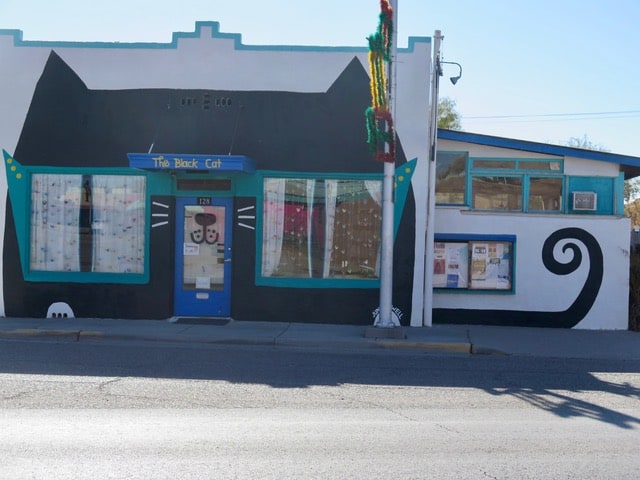
Pomeroy, 40, was a paramedic with the Morton, Ill., fire department until the pandemic spurred her to quit her job and take off with her two children on a cross-country RV trip that lasted nearly a year before they settled temporarily in Albuquerque. In February, while she was in Truth or Consequences to soak in the hot springs, she learned the bookstore was for rent. She found the owner, Charles Perry, who was living in the building while running his craniosacral clinic across the alley. He agreed to rent her the front of the building, so he could continue to live in back.
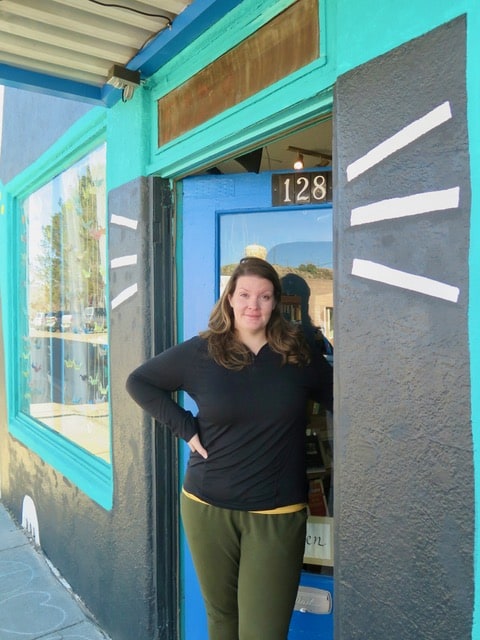
The Black Cat was first opened in 2001 by Rhonda Brittan and Jay Ellerbroek. They bought the building in 1997 after leaving their home in Port Townsend, Wash., on a cross-country driving trip. They initially lived in their trailer until they found, bought and began fixing up the dilapidated building on the far end of Broadway as their residence. After four years, they opened the bookstore in the front and continued to live in the back. But as “the books slowly encroached,” Brittan said, they found a new place to live and expanded the store into the back.
Brittan and Ellerbroek had wanted a bookstore/coffeehouse since reading a Psychology Today article about “the third place” — meaning a space, neither home nor workplace, where people freely discuss ideas without the usual constraints. Being fans of strong coffee from the Puget Sound area, they found local brews too watery. So Ellerbroek began to buy bags of raw beans, roast and brew them. Soon, the Black Cat was the town’s most popular gathering spot with poetry readings, book signings by local authors, a social debating society called the Genius Club, tarot readings by Rebecca Speakes, Scrabble games, occasional musical performances on the patio and pop-up sales of jewelry and yarn. There was also a copy of the Sunday New York Times available and a bulletin board in a glass case outside for town happenings. In late 2019, Brittan and Ellerbroek sold the store to Perry who ran it with volunteers for about a year until the pandemic set in, then closed it.
Pomeroy has no prior experience in bookselling and readily admits she is finding a steep learning curve. To begin with, “Books are like a car,” she said. “New ones are so expensive and the old ones are hardly worth anything.” Brittan is advising her on how organize her shelves, price existing books, what to buy and what not to. The former owners left a good selection of used books and “remainders” — never-sold or -read books at steep discounts — fiction, nonfiction, reference and how-to. Pomeroy would like to focus on literature and poetry, and develop a section for books by local authors. She recently purchased a bundle of books that includes “A Midwife’s Tale: The Life of Martha Ballard based on her diary, 1785-1812” by Laura Thatcher Ulrich and “The Silent Patient” by Alex Michaelides. As for local books, she already has a half dozen titles of the nonviolent mystery series by Amber Foxx of Truth or Consequences and Hillsboro writer Harley G. Shaw’s “River of Spirits: A Natural History of New Mexico’s Las Animas Creek.”
During December, Pomeroy opened sporadically, often just Fridays and weekends, from 7 a.m. to noon. But she hasn’t had any customers before 8 a.m., so that will be her opening time in 2024. She’s also considering staying open a few more days. Prices on books range from 49 cents to $100 for a first edition of a 1946 collection of science fiction called “Adventures in Time and Space.” She also sells strong drip coffee for $2 a cup. There are tables and chairs. So far, most of her clients have been locals.
While I was talking to Pomeroy, Petals June Beasley, a former Truth or Consequences resident who recently moved to Santa Fe and was back for a visit, dropped by for coffee and a muffin. “I love coffee shops. I work online,” she said. “I never stepped foot in the old [Black Cat]. The whole time I lived here, it was closed. But I looked in the window a lot.”


The Black Cat’s literature section is the most extensive in town. Former TorC resident Petals June Beasley, left, who lived here when the Black Cat was closed, recently dropped by for coffee and a muffin.
Beasley is a member of the Black Cat Poets Society, which began at the bookstore, but since the 2020 closure, has moved to Ingo’s Art Cafe’s annex at 420 Broadway. She suggested the group might want to move back to their original home. But Pomeroy said it is not her intention to compete with established businesses, so she would like to sponsor poetry readings for teens. She has Wi-Fi for business uses, but like past owners, does not open it to customers. “I want people to talk among themselves,” she said. “They can always go home to be on their computers.”
Pomeroy is respectful of Truth or Consequences’ reputation as a place for writers and artists, and wants to reincarnate the Black Cat as a gathering place for them. We need people like her here. She keeps finding “artifacts” in the bookshelves — like a ball of yarn and knitting needles, a 1970 letter with a 6 cent stamp and a 1986 Christmas card from Pekin, Ill., near her hometown of Peoria. “I took that as sort of a universal green light,” she said. “Like it’s where I’m supposed to be.”
